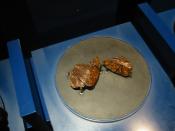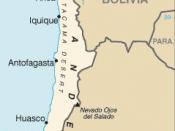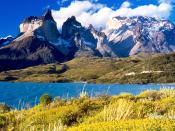The republic of Chile is a wonderful country on the coast of Southern South America. It borders the South Atlantic Ocean and the South Pacific Ocean, between Argentina and Peru. As of July 2002, Chile had 15,498,930 people; 4.3 million of them live in the capital of the country, Santiago. Chile has a surface area of 292,133 square miles.
Chile is a very contrast country. It has low coastal Andes Mountains, fertile valleys and forests in the central region, glaciers in the south and the Atacama Desert in the north. The annual temperature in the north is 58.6 ð F. and in the south, it is 64.4 ð F.
Mining is important to the Chilean economy. It has the world's largest reserve of copper. In addition, iron ore, nitrates, precious metals, and molybdenum are also mined. Also important to the Chilean economy is forestry. Their main wood exports are pine, eucalyptus, pulp, and paper.
Chile has two natural hazards. They are severe earthquakes and active volcanism. In modern times, 28 earthquakes reading greater than 6.9 on the Richter scale have struck Chile. There are over 620 volcanoes, many of them active.
The economy in Chile is very strong, in part, due to the exporting of wheat, corn, beans, sugar beets, potatoes, fruit, beef, poultry, and fish. Grapes are their major agricultural export accounting for 96% of the worlds supply. Chile mainly manufactures metalworking, packages and containers, plastics and textiles.
Chile's communication consists of 2,603 million main line telephones and 944,225 cellular telephones. They also have 180 AM, 64 FM, and 17 shortwave radio broadcast stations. There are 63 (plus 121 repeaters) television broadcast stations and 7 internet service providers.
Tourism in Chile is big with over 1.5 million people visiting a year. In total, revenue from tourism makes up...



Keep going
Seeing that you are in grade 6, this is really good. But you still need to work on structure, KEEP TRYING!
2 out of 3 people found this comment useful.